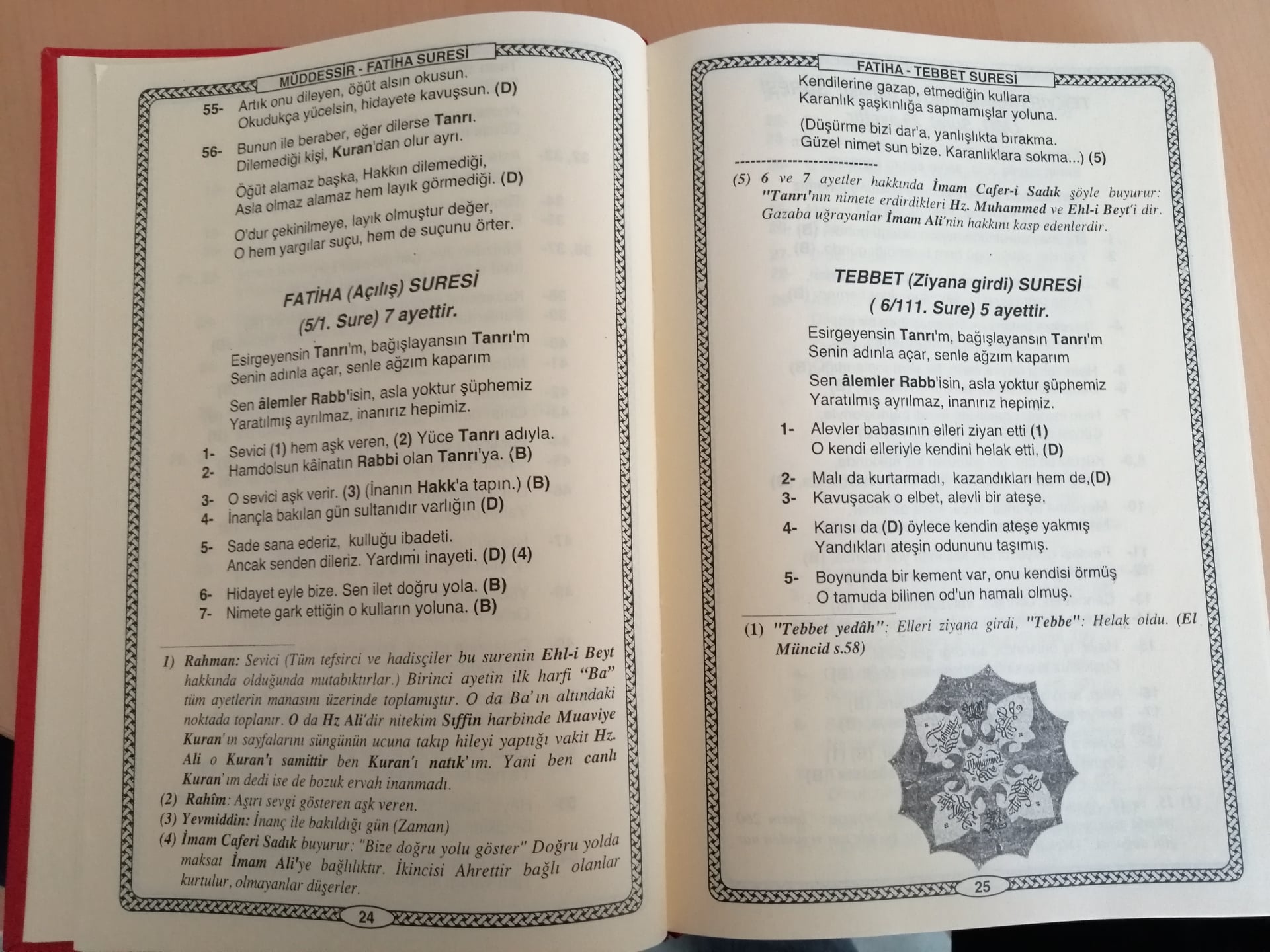This fascinating work by a Turkish Alevi intellectual, Ali Adil Atalay a.k.a. Vaktidolu, renders the entire Qur’an into Turkish verse, complete with metre and rhyme. It has first been brought to the attention of researchers in Qur’anic studies by M. Brett Wilson, who discusses it in his seminal article on Alevi-Bektashi interpretations and translations of the Qur’an.
https://www.euppublishing.com/doi/abs/10.3366/jqs.2015.0212
Alevis are a religious group who have their base in rural regions of Turkey. Their beliefs and practices differ markedly from those of Sunni Muslims, who constitute the majority of the Turkish population. Alevism is characterized by Shi’i components, such as the reverence of the twelve imams, as well as aspects of esoteric and antinomian Sufism. Their rituals (cem) involve singing and dancing. Alevis are the second largest religious group in Turkey but, in contrast to Sunnis, they receive no official support as a religious community. For example, Sunni mosques and their staff are funded by the Turkish Directorate of Religious Affairs, whereas Alevis receive no such support for their assembly houses (cemevi) and their religious leaders (dede).
Whether Alevis are Muslim is hotly debated, both internally and externally. Some Alevis prefer to consider Alevism an independent, possibly even pre-Islamic Turkish religion. Conversely, and especially in the context of contemporary Turkey, many Alevi activists raise a claim to the same kind of resources that Sunni Muslims receive from the Directorate of Religious Affairs. Consequently, these activists tend to emphasize the Islamicness of Alevism and frame it as a brand of Shi’ism.
This explains why, in recent decades, some Alevis, such as Atalay, have engaged with the Qur’an and published on it even though the Qur’an has historically not been central to Alevi beliefs and rituals. Connecting Alevism with the Qur’an is a move to emphasize the Islamicness of Alevism and contest the Sunni claim to defining orthodoxy. It may even be used as a strategy to frame Alevism as the oldest form of Islam, and at the same time an authentically Turkish one, which deploys the powerful Turkish nationalist discourse to legitimize Alevism. Atalay’s use of the traditional Turkish hece metre for his rhyming translation of the Qur’an is part of this strategy to portray Alevism as the authentic Turkish form of Islam.
Shi’i motives are prominent in his translation, which frequently emphasizes the Alevi concept of the “Penc-i Al-i Aba”, as can be seen from the cover: Muhammad, Ali, Fatima, Hasan and Husayn. This is in line with the Shi’i reverence for the ahl al-bayt. Atalay’s translation often explains Qur’anic statements as allegories for the ahl al-bayt or the Twelve Imams and attributes hidden meanings to individual letters of the Qur’an. It is thus not only a Shi’i but also a distinctly esoteric translation. In order to bring across these meanings and uphold the rhyme and metre in Turkish, the meaning of the Qur’an is rendered rather loosely and often more extensively than the Arabic source text.
For example, Q 2:21
يَا أَيُّهَا النَّاسُ اعْبُدُوا رَبَّكُمُ الَّذِي خَلَقَكُمْ وَالَّذِينَ مِن قَبْلِكُمْ لَعَلَّكُمْ تَتَّقُونَ
Yā ayyuhā n‐nāsu ʿbudū rabbakumu lladhī khalaqakum wa’lladhīna min qablikum laʿallakum tattaqūn
could be rendered in English as
“O people, serve your Lord who created you and those that were before you, so that you may guard yourselves (or: be Godfearing)”.
Atalay’s rendering is much longer:
“Ey Hak yolu unutup gafil olan sınıflar
Gelin kulluk ediniz Tanrı sizi yargılar
Dua edin günahtan sakınanlardan olun
Ondan başka Tanrı yok tanıyanlardan olun
Yoktan var edendir O hem önden sonadır O
O’na kulluk edene rahmeti bol veren O.”
In English, this translates approximately to
“O ranks of those who carelessly neglect God’s way
Come and serve God who is your judge on Judgement Day
Pray and be among those who guard themselves against sin
Be among those who know that there is no God but Him
The one who creates from nothing is He, from the beginning until the end is He
The one who gives plentiful mercy to those that serve Him, is He.”
A footnote cites a report according to which the Shi’i imam ‘Ali Zayn al-‘Abidin said, “The most beautiful acts of worship of men are to acknowledge that there is no God but God, to consider Muhammad His prophet and to trust and come to believe that Imam Ali is His legatee and that the Ahl al‐Bayt are the most virtuous of imams.”
Atalay’s translation is monolingual Turkish. In contrast to many other Muslim-majority contexts where bilingual editions that include the Arabic Qur’an are the norm or even mandated by the state, monolingual editions are quite common in Turkey, conforming to a society in which the Turkish language enjoys high prestige and even religious scholarship is often conducted in Turkish. Atalay’s translation is clearly meant to be used as a standalone text and, since it is rhymed, could theoretically even be recited.
Another interesting feature is the arrangement of surahs “in the order of revelation”. This has become very fashionable in Turkey in recent decades since the translation of Muhammad ‘Izzat Darwazah’s “Modern tafsir” from Arabic into Turkish in the 1990s. When Darwazah’s work was published in 1960, it was the first to follow this non-canonical arrangement. The Moroccan philosopher Muhammad ‘Abid al-Jabiri published another “tafsir in the order of revelation” that was also translated into Turkish. Many recent Turkish Qur’an translations and works of tafsir are following “the order of revelation”, usually without discussing the problems involved in establishing a chronology of surahs. This arrangement comes across as a “modern” method of engaging with the Qur’an but, unlike in Darwazah’s case, is rarely connected to a modernist interpretation of the text. Rather, it is used to signify an interest in the history of the Qur’an and/or the Arabs and to connect the Qur’an with the life of Muhammad. For Atalay, the use of this arrangement might be another strategy to underline his devotion to the Ahl al-Bayt.
Johanna Pink


